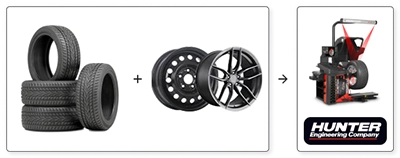When is the best time to install winter tires in Canada?

Should vehicle owners in Canada change their summer tires to winter tires, and what is the best time of year to do so?
It isn't easy to give an exact date, as the weather varies significantly from one Canadian province to another. We suggest that you first consult the provincial guidelines and, most importantly, keep a close eye on the weather to make the best decision on when to have your winter tires installed.
As a rule of thumb, no matter where you are in the country when the temperature is consistently 7 degrees or below, it's time to put on your winter tires.
The 7°C temperature is important for all-season tires because of how the rubber compound reacts. Above this temperature, the compound used in the design of all-season tires will be flexible, reducing braking distances and giving drivers better control of their vehicle.
Below this temperature, on the other hand, drivers will feel their all-season tires stiffen, which translates into longer braking distances, less traction and the cornering grip is not the same as in the summer!
As you may have noticed, winter tires do not have the same grooves and have a higher rate of notches on the tread surface. They grip snow and ice to optimize their performance.
While it's difficult to give an exact date, it's safe to say that temperatures in Canada generally drop quickly into the single digits in October, whether it's night or day.
This is the perfect time to change your summer tires for winter tires.
You need to change all four tires, not just two
Whether you have an all-wheel drive vehicle, front or rear, you must install four winter tires. If you only replace the front or rear tires to save money, it's not a good idea. It's both inefficient and hazardous. All four tires don't work well together, and you'll lose handling and control. You may even lose control of your vehicle.
Winter tires for safe driving
Although only the provinces of Quebec and British Columbia have legislation regarding the use of winter tires, other areas recommend them, and some even offer incentives.
In British Columbia, winter tires are required by law on most highways between October 1 and April 30. This includes Highway 3 (Crowsnest), Highway 5 (Coquihalla), Highway 20 (Chilcotin-Bella Coola), Highway 26 (Barkerville) and Highway 37 (Stewart-Cassiar).
For the following BC highways, winter tire requirements end on March 31. The most popular highways are Highway 99 (Sea to Sky), Highway 3A (Castlegar-Nelson-Creston), Highway 12 (Lytton-Lillooet) and all roads on Vancouver Island.
If you are considering using studded tires, be sure to find out the specific dates they are allowed on the roads in your area. In Ontario, for example, studded tires are only allowed in the northern parts of the province, and their use below Parry Sound or Nipissing could result in a heavy fine. In some areas of northern British Columbia, you will need studded tires or chains.
Before purchasing studded tires, check your provincial laws and regulations to ensure that the tires you buy meet the guidelines for the length of studs allowed in your province and the dates they are accepted.
In Quebec, the province has passed a law requiring all vehicles to be equipped with winter tires between December 1 and March 15.
In Manitoba, you can get a low-interest loan from the government to help purchase eligible winter tires and cover the associated costs.
Ontario also offers an incentive for people who drive with winter tires. This is a reduction in insurance premiums rather than a loan like in Manitoba. The reduction can be up to 5%.
Should I wait to change my tires after the first snowfall?
While many people wait until after the first snowfall to install their winter tires, this is not the optimal time to switch from summer tires or all-season tires to your winter tires.
Winter often arrives unexpectedly, and it's best to be prepared in advance. Avoid long waits, and we recommend planning your tire change ahead of time.
Keep an eye on the weather; when it stays consistently around 7 degrees, call your favorite to make an appointment. And above all, be careful on the roads during the winter months.
Choose your tires carefully
Follow the vehicle manufacturer's recommendations for choosing the right size and type of tires. Have a professional mount the tires on your wheels. It is important to note that many tires are unidirectional and must be mounted in a particular direction to allow for proper snow and water evacuation.
Please browse our extensive selection of tires to find the best winter tires for your vehicle at the lowest prices in Canada.
A little tip: when you have your winter tires installed, take the opportunity to replace your windshield wipers with a winter model, check your car's fluid levels and update your winter kit (mittens, warm clothing, blanket, shovel, a bag of abrasive and grip plates) in your trunk.


